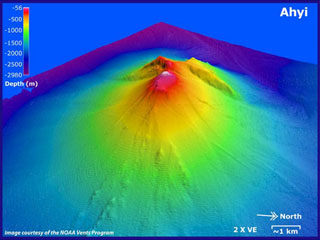Report on Ahyi (United States) — 4 January-10 January 2023
Smithsonian Institution / US Geological Survey
Weekly Volcanic Activity Report, 4 January-10 January 2023
Managing Editor: Sally Sennert.
Please cite this report as:
Global Volcanism Program, 2023. Report on Ahyi (United States) (Sennert, S, ed.). Weekly Volcanic Activity Report, 4 January-10 January 2023. Smithsonian Institution and US Geological Survey.
Ahyi
United States
20.437°N, 145.03°E; summit elev. -50 m
All times are local (unless otherwise noted)
Unrest continued to be detected at Ahyi Seamount during 4-10 January. Daily signals possibly indicating explosions were detected by hydrophone sensors on Wake Island (2,270 km E of Ahyi), though a data outage began at 0118 on 8 January. No activity was visible in mostly cloudy satellite images, though a plume of discolored water originating from the summit region of the seamount was seen in partly cloudy satellite images on 8 January. The Aviation Color Code remained at Yellow (the second lowest level on a four-color scale) and the Volcano Alert Level remained at Advisory (the second lowest level on a four-level scale).
Geological Summary. Ahyi seamount is a large conical submarine volcano ~18 km SE of the island of Farallon de Pajaros in the northern Marianas. Water discoloration has been observed there, and in 1979 the crew of a fishing boat felt shocks over the summit area, followed by upwelling of sulfur-bearing water. On 24-25 April 2001 an explosive eruption was detected seismically by a station on Rangiroa Atoll, Tuamotu Archipelago. The event was well constrained (+/- 15 km) at a location near the southern base of Ahyi. An eruption in April-May 2014 was detected by NOAA divers, hydroacoustic sensors, and seismic stations.
Source: US Geological Survey

